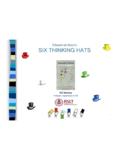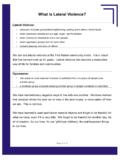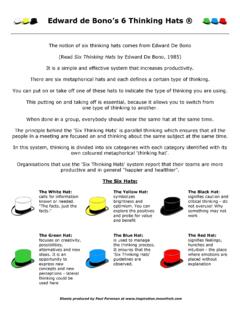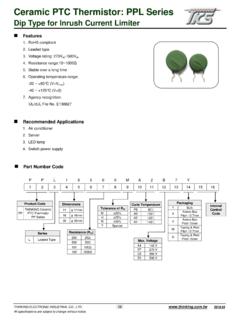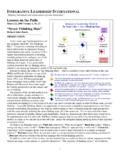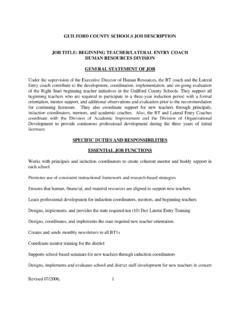Transcription of PENGUIN BOOKS LATERAL THINKING - kioulanis.gr
1 PENGUIN BOOKSL ATERAL THINKINGE dward de Bono has had faculty appointments at the universities of Oxford,London, Cambridge and Harvard. He is widely regarded as the leadingauthority in the direct teaching of THINKING as a skill. He originated theconcept of LATERAL THINKING and developed formal techniques for deliberatecreative THINKING . He has written sixty-two BOOKS , which have beentranslated into thirty-seven languages, has made two television series andthere are over 4,000,000 references to his work on the de Bono has been invited to lecture in fifty-two countries and to addressmajor international conferences. In 1989 he was asked to chair a specialmeeting of Nobel Prize laureates. His instruction in THINKING has beensought by some of the leading business corporations in the world such asIBM, DuPont, Shell, Ericsson, McKinsey, Ciba-Geigy, Ford and manyothers. He has had a planet named after him by the InternationalAstronomic Union and was named by a group of university professors inSouth Africa as one of the 250 people in all of history who have contributedmost to de Bono runs the most widely used programme for the direct teachingof THINKING in schools.
2 This is now in use in many countries around de Bono s key contribution has been his understanding of the brainas a self-organizing system. From this solid base he set out to designpractical tools for THINKING . His work is in use equally in the boardrooms ofsome of the world s largest corporations and with four-year-olds inschool. His design of the Six Hats method provides, for the first time,Western THINKING with a constructive idiom instead of adversarial work is in use in lite gifted schools, rural schools in South Africa andKhmer villages in Cambodia. The appeal of Dr de Bono s work is itssimplicity and more information about Dr de Bono s public seminars, privateseminars, certified training programmes, THINKING programmes for schools,CD Rom, BOOKS and tapes, please contact: Diane McQuaig, The McQuaigGroup, 132 Rochester Avenue, Toronto M4N 1P1, Ontario, Canada.
3 Tel:(416) 488 0008. Fax: (416) 488 4544. Internet: 1 ABC Amber ePub Converter Trial version, d w a r d d e B o n oLateral ThinkingA Textbook of CreativityPenguin BooksPage 2 ABC Amber ePub Converter Trial version, BOOKSP ublished by the PENGUIN GroupPenguin BOOKS Ltd, 80 Strand, London WC2R 0RL, EnglandPenguin Putnam Inc., 375 Hudson Street, New York, New York 10014, USAP enguin BOOKS Australia Ltd, 250 Camberwell Road, Camberwell, Victoria 3124, AustraliaPenguin BOOKS Canada Ltd, 10 Alcorn Avenue, Toronto, Ontario, Canada M4V 3B2 PENGUIN BOOKS India (P) Ltd, 11 Community Centre, Panchsheel Park, New Delhi 110017, IndiaPenguin BOOKS (NZ) Ltd, Cnr Rosedale and Airborne Roads, Albany, Auckland, NewZealandPenguin BOOKS (South Africa) (Pty) Ltd, 24 Sturdee Avenue, Rosebank 2196, South AfricaPenguin BOOKS Ltd, Registered Offices: 80 Strand, London WC2R 0RL, published by Ward Lock Education 1970 Published in Pelican BOOKS 1977 Reprinted in PENGUIN BOOKS 199035 Copyright Edward de Bono, 1970 All rights reservedExcept in the United States of America, this book is sold subject to the condition that it shallnot, by way of trade or otherwise, be lent, re-sold, hired out, or otherwise circulated withoutthe publisher s prior consent in any form of binding or cover other than that in which it ispublished and without a similar condition including this condition being imposed on thesubsequent purchaserISBN.
4 978-0-14-193831-8 Page 3 ABC Amber ePub Converter Trial version, of this bookThe way the mind worksDifference between LATERAL and vertical thinkingAttitudes towards LATERAL thinkingBasic nature of LATERAL thinkingThe use of LATERAL thinkingTechniquesThe generation of alternativesChallenging assumptionsInnovationSuspended judgementDesignDominant ideas and crucial factorsFractionationThe reversal methodBrainstormingAnalogiesChoice of entry point and attention areaRandom stimulationConcepts/divisions/polarizati onThe new word poBlocked by opennessDescription/problem solving/designSummaryPage 4 ABC Amber ePub Converter Trial version, book is intended for use both at home and at school At school theemphasis has traditionally always been on vertical THINKING which is effectivebut incomplete. This selective type of THINKING needs to be supplementedwith the generative qualities of creative THINKING .
5 This is beginning tohappen in some schools but even so creativity is usually treated assomething desirable which is to be brought about by vague is no deliberate and practical procedure for bringing it about Thisbook is about LATERAL THINKING which is the process of using information tobring about creativity and insight restructuring. LATERAL THINKING can belearned, practised and used. It is possible to acquire skill in it just as it ispossible to acquire skill in book should be of use to teachers who are looking for a practicalway to handle this type of THINKING which is becoming ever more importantThe book provides formal opportunities to practise LATERAL THINKING and alsoan explanation of the processes involved. The teacher may either use thebook for his or her own interest or, better still, as a basis for the universal introduction of practical creativity into schooleducation may take some time to come about, parents might not wish towait for this.
6 They might prefer to supplement the school situation withhome instruction in LATERAL is emphasized that there is no antagonism between the two sorts ofthinking. Both are necessary. Vertical THINKING is immensely useful but oneneeds to enhance its usefulness by adding creativity and tempering itsrigidity. Eventually this will be done at school but until that time it may benecessary to do it at book is not intended to be read through at one sitting but workedthrough slowly over months or even years. For that reason many ofthe principles are repeated at intervals throughout the book in order to holdthe subject together and prevent it fragmenting into mere techniques. Inusing the book it is important to remember that practice is far moreimportant than understanding of the 5 ABC Amber ePub Converter Trial version, THINKING is closely related to insight, creativity and humour.
7 All fourprocesses have the same basis. But whereas insight, creativity and humourcan only be prayed for, LATERAL THINKING is a more deliberate process. It is asdefinite a way of using the mind as logical THINKING but a very is concerned with establishing ideas. Education is concernedwith communicating those established ideas. Both are concerned withimproving ideas by bringing them up to date. The only available method forchanging ideas is conflict which works in two ways. In the first way there is ahead on confrontation between opposing ideas. One or other of the ideasachieves a practical dominance over the other idea which is suppressedbut not changed. In the second way there is a conflict between newinformation and the old idea. As a result of this conflict the old idea issupposed to be changed. This is the method of science which is alwaysseeking to generate new information to upset the old ideas and bring aboutnew ones.
8 It is more than the method of science it is the method ofhuman is based on the safe assumption that one only has to go oncollecting more and more information for it to sort itself into useful have developed tools for handling the information: mathematics forextending it, logical THINKING for refining itThe conflict method for changing ideas works well where the informationcan be evaluated in some objective manner. But the method does not workat all when the new information can only be evaluated through the old of being changed the old idea is strengthened and made evermore most effective way of changing ideas is not from outside by conflictbut from within by the insight rearrangement of available information. Insightis the only effective way of changing ideas in a myth situation wheninformation cannot be evaluated objectively. Even when information can beevaluated objectively, as in science, an insight rearrangement ofinformation leads to huge leaps forward.
9 Education is not only concernedwith collecting information but also with the best ways of using informationthat has been ideas lead information rather than lag behind progress is we have developed no practical tools for handling insight. We can onlygo on collecting information and hope that at some stage it will come THINKING is an insight 6 ABC Amber ePub Converter Trial version, , creativity and humour are so elusive because the mind is soefficient The mind functions to create patterns out of its surroundings. Oncethe patterns are formed it becomes possible to recognize them, to react tothem, to use them. As the patterns are used they become ever more pattern using system is a very efficient way of handling established the patterns form a sort of code. The advantage of acode system is that instead of having to collect all the information onecollects just enough to identify the code pattern which is then called fortheven as library BOOKS on a particular subject are called forth by a cataloguecode is convenient to talk of the mind as if it were some information handlingmachine perhaps like a computer.
10 The mind is not a machine, however,but a special environment which allows information to organize itself intopatterns. This self-organizing, self-maximizing, memory system is verygood at creating patterns and that is the effectiveness of inseparable from the great usefulness of a patterning system arecertain limitations. In such a system it is easy to combine patterns or to addto them but it is extremely difficult to restructure them for the patternscontrol attention. Insight and humour both involve the restructuring ofpatterns. Creativity also involves restructuring but with more emphasis onthe escape from restricting patterns. LATERAL THINKING involves restructuring,escape and the provocation of new THINKING is closely related to creativity. But whereas creativity istoo often only the description of a result, LATERAL THINKING is the description ofa process. One can only admire a result but one can learn to use aprocess.
